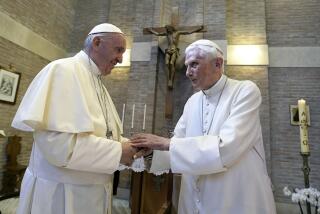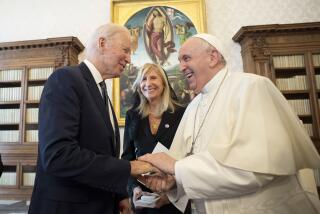A New Pope: Benedict XVI
VATICAN CITY — Joseph Ratzinger, a renowned theologian and hard-line enforcer of Catholic Church doctrine for the last two decades, was chosen Tuesday to succeed his friend and close ally Pope John Paul II. Ratzinger, 78, became Pope Benedict XVI, the 265th leader of the world’s largest and most powerful Christian institution.
The swift election of the German-born Ratzinger by the church’s College of Cardinals was widely seen as a vote for continuity of John Paul’s policies, signaling an endorsement of the church’s most conservative teachings.
White smoke indicating the pope’s election puffed from a skinny chimney atop the Sistine Chapel at 5:50 p.m., and onlookers started to cheer. Five minutes later, the great bell of St. Peter’s began to toll.
Applause and chants of “Viva il papa!” rang out. People from across Rome converged on St. Peter’s Square, running through streets and across bridges over the Tiber River to join the swelling crowd.
After Ratzinger’s name was read to the assembled multitude, he stepped onto a balcony and described himself as “a simple, humble worker in the vineyard of the Lord.”
“The fact that the Lord can work and act even with insufficient means consoles me,” said the new pope, dressed in flowing white robes and the scarlet papal cape and golden stole, “and above all I entrust myself to your prayers.”
White-haired and slightly hunched, Ratzinger smiled broadly and waved somewhat awkwardly. Where John Paul regularly embraced and played enthusiastically to his audiences, Pope Benedict XVI appeared a bit stiff and kept his remarks short.
The new pope will lead a church in crisis, sharply divided after John Paul’s 26-year reign. Despite John Paul’s personal magnetism, many of the church’s 1 billion members are seriously disaffected, the faith is losing ground in many parts of the world to other religions and is under threat from radical Islam and secularism. Reaction to the election of the oldest pope in two centuries was mixed, both in a St. Peter’s Square packed with people eager to hear the news, and around the world.
Liberal Roman Catholics who had hoped for change and more openness toward the role of women in the church, birth control and homosexuality, were disappointed and predicted a status quo -- or worse, a leap backward -- that would drive even more people from the church.
“This is a disaster,” said Rea Howarth, co-director of the Quixote Center, a Catholic lay organization based in Brentwood, Md., that is involved in human rights work in Latin America. “The church has lost so much credibility. Now I’m afraid that more Catholics will just turn their backs and walk away.”
Others said Ratzinger was the logical choice to succeed John Paul given his closeness to the late pontiff, his similar views on key issues affecting the church and the increasingly prominent role he played in church affairs as John Paul’s health deteriorated.
“The cardinals chose the best known and most respected of their number, a man they each know as a great listener and a sympathetic listener,” said George Wiegel, one of John Paul’s biographers. “This was not only a tremendous affirmation of the past 26 1/2 years, it was a vote of confidence in Joseph Ratzinger as the man best fitted to give an evangelical thrust to this papacy.”
Meeting secretly for less than 24 hours, the 115 cardinals locked inside the Sistine Chapel elected Ratzinger on the fourth ballot, then burned the papers on which each had penned a name in disguised handwriting.
Initial details quickly emerged on how the cardinals reached the two-thirds majority needed for victory. While many observers had thought Ratzinger would be too polarizing a figure at this crucial juncture in church history, several cardinals appeared to have fallen into line behind the image of a strong leader who represented unambiguous moral authority.
On the morning of his election, Ratzinger had breakfast with four cardinals from Asia and Africa and also Roger M. Mahony of Los Angeles. At breakfast, and throughout all the meetings leading to the conclave, Ratzinger was able to address each cardinal by name and spoke to them in shared languages, Mahony said.
Ratzinger’s tough-minded advocacy of the primacy of Catholicism evidently appealed to cardinals in those parts of the developing world where holders of the faith are under attack by militant Islam or repressive regimes.
He drew those battle lines on Monday in a Mass that opened the conclave. Before a worldwide television audience, Ratzinger used his homily to demand rigid adherence to the traditional teachings of the church, too often buffeted, he said, by “the waves of today’s fashions or the latest novelties.”
Ratzinger said the Mass, directed the conclave and earlier delivered an emotional homily at John Paul’s funeral -- all as part of his position as dean of the College of Cardinals. That gave him a unique and powerful platform from which to win the votes of fellow cardinals.
Cardinal Edward M. Egan of New York cited Ratzinger’s handling of the funeral, in which many observers thought Ratzinger showed a softer side of his personality, as one of the factors that persuaded other cardinals to vote for him.
Ratzinger reportedly went into the conclave with about 50 of the needed 77 votes in the bank. The more reform-minded wing of the college was not able to agree on a single candidate. Although cardinals entering the conclave had spoken of widely divergent agendas, from democratizing the church, expanding dialogue with Islam and perhaps turning to dynamic Latin America for leadership, the opposition quickly melted away.
The cardinals were sworn to secrecy about the inner workings of the conclave, where they took one vote Monday afternoon and two Tuesday morning before the final tally Tuesday afternoon.
Mahony, without describing the breakdown of the vote, said there was a “sense of fraternity and a sense of consensus among men ... just really a good, friendly group.”
Italian Cardinal Ennio Antonelli of Florence said, “There was a climate of great celebration, unity and communion.
“It was a fast election,” he told a regional television station, “and that speaks for itself.”
After the winning vote, Ratzinger was asked by another senior cardinal whether he accepted the position. He responded in the affirmative, and then left for a side room, often called the Room of Tears because of the emotion of the moment, to change into papal vestments that had been prepared in three sizes.
Each cardinal was then allowed to approach him for a few words, Rigali, the cardinal from Philadelphia, recounted later. They then sang a prayer of thanksgiving, the Te Deum, and got ready for the public announcement.
Rigali said Ratzinger explained his choice of the name Benedict, after two earlier Benedicts: the World War I-era pontiff who attempted unsuccessfully to make peace, and St. Benedict, the monk and patron saint of Europe.
“So obviously the pope has launched the idea that coming as he does from Western Europe that he wants to do what he can to promote the well-being of Europe,” Rigali said. “And the cardinal made specific mention of this, that St. Benedict instructs people to prefer nothing [more] than the love of Christ.”
Ratzinger grew up in Hitler’s Germany and joined the Hitler Youth movement when membership was obligatory. But he was never a Nazi and his family opposed the Nazis, according to his autobiography.
For the last 24 years, Ratzinger has headed the Congregation for the Doctrine of the Faith, the successor to the Grand Inquisition of the Middle Ages. He was the man who had John Paul’s ear for all matters of orthodoxy and doctrine, and in the late pontiff’s declining years, he gained more and more power within the curia, or Vatican bureaucracy.
As theological watchdog, Ratzinger has silenced dissent within the church and recently labeled other faiths, including Protestant denominations, “deficient.”
At the same time, he is often described by admirers as personally unassuming and gracious. He is also widely regarded for his acute intellectual prowess and piety.
He was one of only two cardinals participating in the conclave who were not appointed by the late John Paul. His election was one of the swiftest in the last century.
Despite his hard-nosed reputation, several cardinals and other Catholics said Ratzinger would now have to make the transition to universal pastor.
“Cardinal Ratzinger remains and will continue to remain the same person,” said a subdued Belgian Cardinal Gottfried Danneels on Tuesday night. “But for the moment he is universal pastor of the church. He is not anymore the head of the Congregation for the Doctrine of the Faith.... When you are a pope, you have to be the pastor of everyone and everything which happens in the church.”
Mahony predicted that Ratzinger would meet the challenge.
“I think you’re going to see that spiritual, pastoral side of him emerge,” Mahony said in an interview.
Sister Mary Sujita Kallupurakkathu, superior general of the Sisters of Notre Dame, said she hoped Ratzinger-the-pope would listen to the world’s needs “with a different heart.”
“I want to believe in my heart that yesterday what he said was a ‘cardinal,’ but today he stands and speaks to us for change as ‘pope,’ ” she said. “The past experience is a little scary, I have to admit.”
She and others had argued that the future viability of the church rested on its ability to modernize, adapt and become more flexible. A pope like Ratzinger, they maintain, would not be a force for change.
Cardinal Karl Lehmann, also of Germany, said, “It is obvious that in today’s world with its multitude of opinions not everyone, even in our own church, could and wanted to follow him. But his theological work was always respected, even by people with differing opinions.”
Catholics everywhere had waited expectantly to learn who would ascend the throne of St. Peter after the death of John Paul on April 2 at 84.
The announcement of the new pope was suspenseful. The Vatican had said the bell of St. Peter’s would ring to coincide with the white smoke from the chimney, but the bell remained still for about five minutes.
After it tolled and the crowd cheered, it was about half an hour before Chilean Cardinal Jorge Arturo Medina Estevez, the senior deacon, emerged from behind crimson velvet draperies onto the balcony overlooking St. Peter’s Square.
In five languages, he greeted “brothers and sisters” and then announced in Latin: “Habemus papam.” (We have a pope.) With a flourish he announced the first name, in Latin, Josephum, followed by a pause for dramatic effect. And then: Sanctae Romanae Ecclesiae Cardinalem Ratzinger.
The new pope appeared on the balcony, dressed in the papal vestments.
Times staff writers Richard Boudreaux and Larry B. Stammer contributed to this report.
*
(BEGIN TEXT OF INFOBOX)
A papal transition
When Joseph Ratzinger gave his first blessing as Pope Benedict XVI, it was the culmination of several weeks of uncertainty in the Vatican after Pope John Paul II’s death. The events leading up to the choice of pope, and what’s next:
April 2: Pope John Paul II dies.
April 4: John Paul’s body displayed in St. Peter’s Basilica.
April 6: Cardinals select April 18 as first day of conclave.
April 8: John Paul is buried in Vatican grottoes.
April 18: Conclave begins; first vote is inconclusive.
April 19: Cardinal Joseph Ratzinger is elected 265th pope on the fourth vote, takes the name Benedict XVI.
Today: Benedict XVI will deliver a homily at Mass in the Sistine Chapel.
April 24: Mass inaugurating Pope Benedict XVI in St. Peter’s Square.
Source: Vatican press office. Graphics reporting by Tom Reinken.
More to Read
Sign up for Essential California
The most important California stories and recommendations in your inbox every morning.
You may occasionally receive promotional content from the Los Angeles Times.











